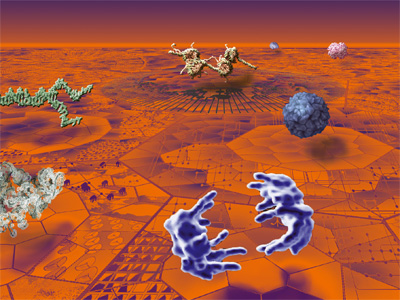Visualizing Biological Data (VIZBI) 2012
 Heidelberg, 6-8 March 2012
Heidelberg, 6-8 March 2012
Report by Elisa Loza, Agent and scientific statistician, Rothamsted Research.
Highlights
Visualizing Biological Data (VIZBI) 2012 featured state-of-the-art software tools developed and used by scientists to study biological data.
There seems to an increasing interest in developing interactive and user-friendly software tools for visualisation of biological data.
Software tools for data visualisation need to adapt to the increasingly large, heterogeneous and noisy nature of biological data.
Communication between scientists on the development end of software and on the end-user side is essential to produce software packages that are useful and relevant.
Conference report
VIZBI 2012's opening keynote was delivered by Georges Grinstein who presented a summary of some of the main methods and packages available in the visualisation community. He spoke about one of the grand challenges in this area; to reach not only the scientific community but also the general public by developing software visualization packages for the masses. To this end, the Institute for Visualization and Perception Research (co-Directed by Georges Grinstein) in the University of Massachusetts Lowell has developed Weave. Weave is an extremely flexible web-based platform "designed to enable visualization of any available data by anyone for any purpose"; from health to income indicators, from demographic to wind energy capacity data.
An interesting point Georges Grinstein made was the lack of user-tailored visualisations in the community. A visualisation system hasn't been developed yet that presents the information tailored to what is known about
the user (e.g. as google does by displaying user-specific adverts). Weave records session histories of users, ie. the paths that a user followed to arrive to a certain visualization. This is a first step to user-tailored visualisations becoming one day available.
The "Visualizing Single Genome Data" session featured visualisation software tools used for next-generation sequence (NGS) assembly and genome (2D and 3D) exploration.
Current NGS technologies deliver several thousands of short DNA sequence fragments. Sequence assembly is the process of combining these sequence fragments into contiguous stretches of DNA called contigs, based on similarity between the fragments. In traditional genome assembly, contigs are subsequently combined into even longer
stretches of data called scaffolds, until most of the genome is eventually covered.
Software tools presented in this session included:
All of the above use novel graph-based representations to display and explore genomic data.
The molecular biology community is interested in the analysis and visualisation of the folding structure of RNA because it can be taken as an aproxi of function. A challenge in RNA visualisation, however, is the variation in RNA size; from 18 to more than 9k nucleotides. The RNAfold web server predicts and displays secondary structures of single stranded RNA or DNA sequences.
The area of transcriptomics, or expression profiling, assesses the expression level of mRNAs in a given cell population. Key scientific questions include the detection of differentially expressed genes under changing conditions; identification of genes expressed in the same process; and derivation of gene regulatory networks. Visualisation tools to aid answering these questions face challenges related to the high dimensional, noisy and heterogeneous nature of transcriptomic data. Kay Nieselt and colleagues at the University of Tübingen have developed Mayday, a platform for the analysis and visualisation of transcriptomic data.
Scientific illustrators David Goodsell and Graham Johnson demonstrated how biological visualisation can be used to inspire. Their work focuses in the production of images that convey the details of cellular and molecular biology for scientific education and outreach purposes.
Valerie Daggett, from the University of Washington, presented Dynameomics, one of the world's largest scientific
computation projects, which aims to characterise the motion for all proteins at atomic details.
An example of a wiki engine for storing, maintaining and visualising biological pathway information was presented by Alex Pico. Wikipathways currently contains 1,708 pathways and counts with 2,281 registered users. Other software packages presented during VIZBI 2012 included:
- VIPER, a BBSRC-funder project that aims to produce a visual interactive software tool "to remove errors in animal pedigree information caused by administrative and data handling faults" so that data can be reliable for further programmes or analyses.
- Vaa3D a high-performance software tool for the analysis of 3D microscopic digital images, developed by Gene Myers - the inventor of BLAST - and his team.
- Utopia Protein Analysis Suite, a collection of interactive software tools for analysing protein sequence and structure, and Utopia Documents, a tool for annotating documents, inspecting data referenced in scientific papers and looking for clarification of given terms in a document using the web.
- MEGAN, a software tool for the analysis and visualisation of the taxonomical and functional content of communities of microorganisms, based on molecular sequence data directly extracted from the community (or metagenomics).
- SPREAD an application to analyse and visualise geographically structured genetic signal within and among species (or phylogeography).
Videos of all VIZBI 2012 talks are available.
